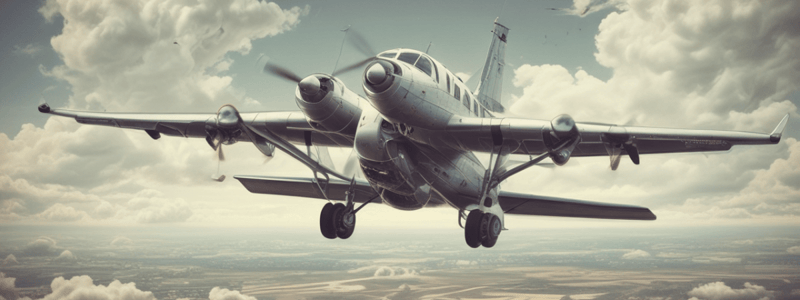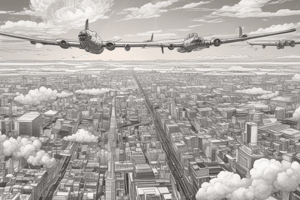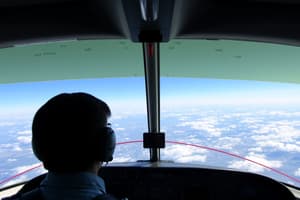Podcast
Questions and Answers
What is the primary goal of air traffic control services in controlled airspace?
What is the primary goal of air traffic control services in controlled airspace?
- To increase the number of flights in a given airspace
- To minimize radio communications between pilots
- To enhance the visibility of aircraft to ground personnel
- To provide separation between aircraft and facilitate safe movement (correct)
Which of the following is a requirement for pilots operating in controlled airspace?
Which of the following is a requirement for pilots operating in controlled airspace?
- Pilots must comply with air traffic control instructions (correct)
- Pilots should avoid using radio communication
- Pilots are encouraged to fly at higher altitudes only
- Pilots must operate under visual flight rules at all times
How does flying in controlled airspace generally impact flight safety?
How does flying in controlled airspace generally impact flight safety?
- It creates a more structured environment, enhancing safety (correct)
- It tends to result in higher traffic density and increased risks
- It offers no significant change in safety dynamics
- It limits pilots' abilities to communicate with ATC
What role do air traffic controllers play in controlled airspace?
What role do air traffic controllers play in controlled airspace?
What is a significant characteristic of uncontrolled airspace compared to controlled airspace?
What is a significant characteristic of uncontrolled airspace compared to controlled airspace?
What is expected of pilots regarding radio communication in controlled airspace?
What is expected of pilots regarding radio communication in controlled airspace?
Which aspect of flying through controlled airspace offers crucial information to pilots?
Which aspect of flying through controlled airspace offers crucial information to pilots?
What impact does knowledge of operational safety considerations have on pilots?
What impact does knowledge of operational safety considerations have on pilots?
Which of the following best describes controlled airspace?
Which of the following best describes controlled airspace?
What does the structured environment of controlled airspace help to mitigate?
What does the structured environment of controlled airspace help to mitigate?
Pilots flying in uncontrolled airspace have the responsibility of navigating and avoiding other aircraft.
Pilots flying in uncontrolled airspace have the responsibility of navigating and avoiding other aircraft.
Controlled airspace does not require pilots to maintain situational awareness.
Controlled airspace does not require pilots to maintain situational awareness.
Uncontrolled airspace is characterized by the availability of air traffic control services for separation of aircraft.
Uncontrolled airspace is characterized by the availability of air traffic control services for separation of aircraft.
The absence of ATC services in uncontrolled airspace can enhance flight safety during high traffic periods.
The absence of ATC services in uncontrolled airspace can enhance flight safety during high traffic periods.
Pilots are not required to be proficient in using radio communications when flying in uncontrolled airspace.
Pilots are not required to be proficient in using radio communications when flying in uncontrolled airspace.
Pre-flight planning is less critical in uncontrolled airspace compared to controlled airspace.
Pre-flight planning is less critical in uncontrolled airspace compared to controlled airspace.
Controlled airspace provides a regulated environment which enhances overall flight safety.
Controlled airspace provides a regulated environment which enhances overall flight safety.
Proper airmanship is not necessary for pilots operating in uncontrolled airspace.
Proper airmanship is not necessary for pilots operating in uncontrolled airspace.
The complexity of operations in controlled airspace demands a lower level of skill from pilots.
The complexity of operations in controlled airspace demands a lower level of skill from pilots.
Visual scanning techniques are less important in controlled airspace than in uncontrolled airspace.
Visual scanning techniques are less important in controlled airspace than in uncontrolled airspace.
Why is safety a priority for pilots in varying airspaces?
Why is safety a priority for pilots in varying airspaces?
What role do established procedures play in controlled airspace?
What role do established procedures play in controlled airspace?
How does structured navigation in controlled airspace impact pilots' decision-making?
How does structured navigation in controlled airspace impact pilots' decision-making?
In what way does air traffic control support pilots in controlled airspace?
In what way does air traffic control support pilots in controlled airspace?
What is the significance of two-way radio communication for pilots in controlled airspace?
What is the significance of two-way radio communication for pilots in controlled airspace?
How do pronounced differences between controlled and uncontrolled airspace affect flight safety?
How do pronounced differences between controlled and uncontrolled airspace affect flight safety?
What impact can weather updates from ATC have on flight safety?
What impact can weather updates from ATC have on flight safety?
What challenges do pilots face when operating in uncontrolled airspace?
What challenges do pilots face when operating in uncontrolled airspace?
Why is it crucial for pilots to review operational safety considerations?
Why is it crucial for pilots to review operational safety considerations?
How does the level of traffic in controlled airspace influence pilot behavior?
How does the level of traffic in controlled airspace influence pilot behavior?
Study Notes
Importance of Controlled Airspace
- Controlled airspace is an area where air traffic control (ATC) services are provided, crucial for aviation safety.
- Acts like a regulatory framework to manage air traffic flow, preventing collisions.
- Enhances pilots' situational awareness through information and instructions from ATC.
Role of Air Traffic Control (ATC)
- ATC serves as the central authority in controlled airspace, coordinating altitude, speed, and heading changes.
- Utilizes radar and radio frequencies to monitor aircraft and manage potential conflicts.
- Functions similarly to a conductor, orchestrating safe passage through busy skies.
Safety Protocols in Controlled Airspace
- Special protocols include speed limitations, altitude restrictions, and entry/exit procedures.
- These measures act as safeguards against disorder, promoting safety and reducing risk.
Historical Lessons and Compliance
- Past incidents highlight the importance of adherence to safety measures and ATC instructions.
- Non-compliance in controlled airspace can lead to severe consequences, from reprimands to accidents.
Technology in Controlled Airspace
- Modern advancements such as sophisticated radar, GPS precision, and robust communication systems enhance safety.
- Continuous evolution in technology shapes the future of safe aviation practices.
Controlled vs. Uncontrolled Airspace
- Controlled airspace provides structure while uncontrolled airspace offers freedom of navigation but places more responsibility on pilots.
- Pilots in uncontrolled airspace must maintain vigilance and utilize visual or instrument flight rules for safety.
Efficiency Considerations
- Controlled airspace may result in longer routes and waiting times, akin to traffic at busy intersections.
- Uncontrolled airspace allows for more direct routes but heightens risks, necessitating strong situational awareness.
Pilot Decision-Making
- A wise pilot balances the benefits of each type of airspace to chart safe and efficient flight paths.
- Mastery of knowledge and skills directly correlates with enhanced safety and operational efficiency.
Summary of Flight Safety
- The type of airspace impacts the expected safety level during flight operations.
- Controlled airspace supports safe movement through structured monitoring and established rules, while uncontrolled airspace demands increased pilot alertness.
Controlled Airspace
- Controlled airspace is where Air Traffic Control (ATC) services are provided, aimed at enhancing flight safety.
- Functions as a regulatory structure managing air traffic to prevent collisions, similar to a busy highway with traffic signs.
- Pilots receive critical information and instructions from ATC, improving situational awareness and navigation.
- ATC coordinates vital operational factors like altitude, speed, and heading changes, operating like chess masters to ensure safety.
- Strict protocols exist, including speed limitations, altitude restrictions, and defined entry and exit procedures, to uphold order.
- Historical incidents underscore the importance of compliance with regulations, highlighting how lapses can lead to accidents.
- Non-compliance with controlled airspace rules can result in severe consequences, including warnings, license suspension, or accidents.
Uncontrolled Airspace
- Uncontrolled airspace allows pilots to navigate without direct ATC oversight, offering freedom but increasing personal responsibility for safety.
- Pilots must be vigilant in monitoring for other aircraft, with fewer communication requirements compared to controlled airspace.
- While uncontrolled airspace may provide more direct flight paths, it demands advanced situational awareness and decision-making skills.
- Pilots must utilize visual flight rules or instrument flight rules, depending on conditions, in the absence of ATC guidance.
Comparisons of Airspace
- Controlled airspace prioritizes safety, even if it occasionally leads to longer flight routes and waiting times.
- Uncontrolled airspace can yield more efficient routes but requires pilots to be proactive in ensuring their safety and the safety of others.
- Pilots benefit from understanding the strengths and risks associated with both controlled and uncontrolled airspace, allowing for better decision-making.
Safety and Operational Considerations
- Complex operational environments necessitate a high level of skill, primarily in dense traffic areas around airports.
- Uncontrolled airspace places the burden of navigation and collision avoidance squarely on pilots, emphasizing the need for awareness and self-separation.
- Poor visibility and high traffic conditions increase the challenges in uncontrolled airspace, making communication techniques vital.
Final Thoughts
- Controlled airspace provides safety through regulation and oversight, while uncontrolled airspace requires comprehensive pilot preparedness and vigilance.
- Proficient use of both airspace types leads to safer, more efficient flights through informed decision-making and situational awareness.
- Effective pre-flight planning and in-flight vigilance are essential across both airspace categories to mitigate risks and enhance safety.
Importance of Controlled Airspace
- Controlled airspace is an area where air traffic control (ATC) services are provided, crucial for aviation safety.
- Acts like a regulatory framework to manage air traffic flow, preventing collisions.
- Enhances pilots' situational awareness through information and instructions from ATC.
Role of Air Traffic Control (ATC)
- ATC serves as the central authority in controlled airspace, coordinating altitude, speed, and heading changes.
- Utilizes radar and radio frequencies to monitor aircraft and manage potential conflicts.
- Functions similarly to a conductor, orchestrating safe passage through busy skies.
Safety Protocols in Controlled Airspace
- Special protocols include speed limitations, altitude restrictions, and entry/exit procedures.
- These measures act as safeguards against disorder, promoting safety and reducing risk.
Historical Lessons and Compliance
- Past incidents highlight the importance of adherence to safety measures and ATC instructions.
- Non-compliance in controlled airspace can lead to severe consequences, from reprimands to accidents.
Technology in Controlled Airspace
- Modern advancements such as sophisticated radar, GPS precision, and robust communication systems enhance safety.
- Continuous evolution in technology shapes the future of safe aviation practices.
Controlled vs. Uncontrolled Airspace
- Controlled airspace provides structure while uncontrolled airspace offers freedom of navigation but places more responsibility on pilots.
- Pilots in uncontrolled airspace must maintain vigilance and utilize visual or instrument flight rules for safety.
Efficiency Considerations
- Controlled airspace may result in longer routes and waiting times, akin to traffic at busy intersections.
- Uncontrolled airspace allows for more direct routes but heightens risks, necessitating strong situational awareness.
Pilot Decision-Making
- A wise pilot balances the benefits of each type of airspace to chart safe and efficient flight paths.
- Mastery of knowledge and skills directly correlates with enhanced safety and operational efficiency.
Summary of Flight Safety
- The type of airspace impacts the expected safety level during flight operations.
- Controlled airspace supports safe movement through structured monitoring and established rules, while uncontrolled airspace demands increased pilot alertness.
Studying That Suits You
Use AI to generate personalized quizzes and flashcards to suit your learning preferences.
Related Documents
Description
In this module, we will explore the impact of airspace design on operational safety, a critical skill for pilots. We will examine controlled airspace and its importance in maintaining flight safety. Join us as we deepen our understanding of airspace classifications and their practical applications.




